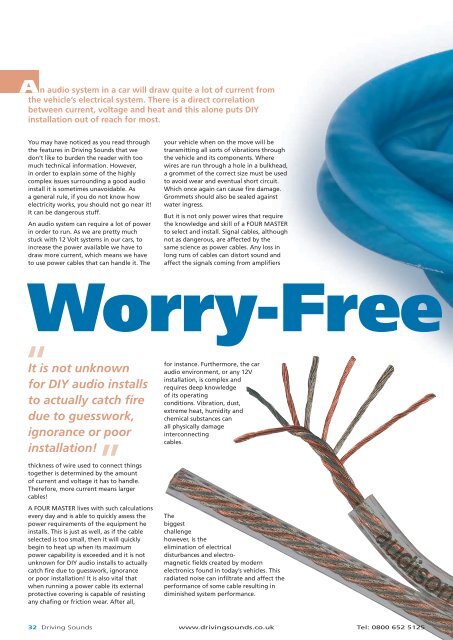For People Who Love Music On The Move - Four Masters
For People Who Love Music On The Move - Four Masters
For People Who Love Music On The Move - Four Masters
You also want an ePaper? Increase the reach of your titles
YUMPU automatically turns print PDFs into web optimized ePapers that Google loves.
A<br />
n audio system in a car will draw quite a lot of current from<br />
the vehicle’s electrical system. <strong>The</strong>re is a direct correlation<br />
between current, voltage and heat and this alone puts DIY<br />
installation out of reach for most.<br />
You may have noticed as you read through<br />
the features in Driving Sounds that we<br />
don’t like to burden the reader with too<br />
much technical information. However,<br />
in order to explain some of the highly<br />
complex issues surrounding a good audio<br />
install it is sometimes unavoidable. As<br />
a general rule, if you do not know how<br />
electricity works, you should not go near it!<br />
It can be dangerous stuff.<br />
An audio system can require a lot of power<br />
in order to run. As we are pretty much<br />
stuck with 12 Volt systems in our cars, to<br />
increase the power available we have to<br />
draw more current, which means we have<br />
to use power cables that can handle it. <strong>The</strong><br />
thickness of wire used to connect things<br />
together is determined by the amount<br />
of current and voltage it has to handle.<br />
<strong>The</strong>refore, more current means larger<br />
cables!<br />
A FOUR MASTER lives with such calculations<br />
every day and is able to quickly assess the<br />
power requirements of the equipment he<br />
installs. This is just as well, as if the cable<br />
selected is too small, then it will quickly<br />
begin to heat up when its maximum<br />
power capability is exceeded and it is not<br />
unknown for DIY audio installs to actually<br />
catch fire due to guesswork, ignorance<br />
or poor installation! It is also vital that<br />
when running a power cable its external<br />
protective covering is capable of resisting<br />
any chafing or friction wear. After all,<br />
your vehicle when on the move will be<br />
transmitting all sorts of vibrations through<br />
the vehicle and its components. Where<br />
wires are run through a hole in a bulkhead,<br />
a grommet of the correct size must be used<br />
to avoid wear and eventual short circuit.<br />
Which once again can cause fire damage.<br />
Grommets should also be sealed against<br />
water ingress.<br />
But it is not only power wires that require<br />
the knowledge and skill of a FOUR MASTER<br />
to select and install. Signal cables, although<br />
not as dangerous, are affected by the<br />
same science as power cables. Any loss in<br />
long runs of cables can distort sound and<br />
affect the signals coming from amplifiers<br />
Worry-Free<br />
It is not unknown<br />
for DIY audio installs<br />
to actually catch fire<br />
due to guesswork,<br />
ignorance or poor<br />
installation!<br />
for instance. Furthermore, the car<br />
audio environment, or any 12V<br />
installation, is complex and<br />
requires deep knowledge<br />
of its operating<br />
conditions. Vibration, dust,<br />
extreme heat, humidity and<br />
chemical substances can<br />
all physically damage<br />
interconnecting<br />
cables.<br />
<strong>The</strong><br />
biggest<br />
challenge<br />
however, is the<br />
elimination of electrical<br />
disturbances and electromagnetic<br />
fields created by modern<br />
electronics found in today’s vehicles. This<br />
radiated noise can infiltrate and affect the<br />
performance of some cable resulting in<br />
diminished system performance.<br />
32 Driving Sounds www.drivingsounds.co.uk<br />
Tel: 0800 652 5125


